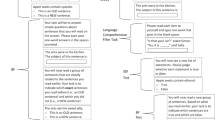Abstract
The use of mental imagery and mnemonic devices as aids to information encoding and retrieval has been promoted by orators, teachers, and mnemonists for at least the past 2000 years (a comprehensive account of the history of mnemonic devices is given by Yates, 1966; a discussion of the nature of mnemonic devices is offered by Bellezza elsewhere in this volume; examples of mnemonic use in everyday contemporary life can be found in Furst, 1972 and Baddeley, 1976). Until recently, these claims were not widely accepted by the scientific commu nity because the evidence on which they were based was largely anecdotal. That is no longer the case. As the other chapters in this volume make clear, controlled experimental studies conducted over the past 20 years have substantiated the general claim that imagery and mnemonics facilitate the learning and recall of specific items of information and that these techniques can be taught to many types of people.
Access this chapter
Tax calculation will be finalised at checkout
Purchases are for personal use only
Preview
Unable to display preview. Download preview PDF.
Similar content being viewed by others
References
Baddeley, A. D. (1976). The psychology of memory. New York: Basic Books.
Bellezza, F. S. (1981). Mnemonic devices: Classification, characteristics, and criteria. Review of Educational Research, 51, 247–275.
Borkowski, J., Levers, S., & Gruenenfelder, T. (1976). Transfer of mediational strategies in children: The role of activity and awareness during strategy acquisition. Child Development, 47, 779–786.
Bower, G. H., & Clark, M. C. (1969). Narrative stories as mediators for serial learning. Psychomomic Science, 14, 181–182.
Bracht, G. H., & Glass, G. V. (1968). The external validity of experiments. American Educational Research Journal, 5, 437–474.
Bransford, J. D. (1979). Human cognition: Learning, understanding, and remembering. Belmont, CA: Wadsworth.
Cubberly, W. E., Weinstein, C. E., & Wicker, F. (1977). Training versus instructions in elaborated and non-elaborated versions of the method of loci. Paper presented at the annual meeting of the American Educational Research Association, April 4–8, New York.
Cunningham, D. J., & Snowman, J. (1975). Imagery and narrative stories as mediators for one trial serial and free recall list learning. Paper presented at the annual meeting of the American Educational Research Association, March 30-April 3, Washington, DC.
Dansereau, D. F. (1978). The development of a learning strategies curriculum. In H. H. O’Neill (Ed.), Learning strategies. New York: Academic Press.
Furst, B. (1972). Stop forgetting. Garden City, NY: Doubleday.
Groninger, K. D. (1971). Mnemonic imagery and forgetting. Psychonomic Science, 23, 161–163.
Jenkins, J. J. (1979). Four points to remember: A tetrahedral model of memory experiments. In L. S. Cermak & F. I. M. Craik (Eds.), Levels of processing in human memory. Hillsdale, NJ: Erlbaum Associates.
Kennedy, B., & Miller, D. (1976). Persistent use of verbal rehearsal as a function of infor mation about its value. Child Development, 47, 566–569.
Krebs, E. W., Snowman, J., & Smith, S. H. (1978). Teaching new dogs old tricks: Facilitating prose learning through mnemonic training. Journal of Instructional Psychology, 5, 33–39.
Kreutzer, M., Leonard, C., & Flavell, J. (1975). An interview study of children’s knowledge about memory. Monographs of The Society for Research in Child Development, 40(1, Serial No. 159).
Levin, J. R. (1982). Pictures as prose learning devices. In A. Flammer & W. Kintsch (Eds.), Advances in psychology: Vol. 8. Discourse processing. Amsterdam: North-Holland Publishing Co.
Levin, J. R., Davidson, R. E., Wolff, P., & Citron, M. (1973). A comparison of induced imagery and sentence strategies in children’s paired-associate learning. Journal of Educational Psychology, 64, 306–309.
Levin, J. R., McCormick, C. B., & Dretzke, B. J. (1981). A combined pictorial mnemonic strategy for ordered information. Educational Communications and Technology Journal, 29, 219–226.
Meyer, B. J. F. (1975). The organization of prose and its effects on memory. Amsterdam: North-Holland Publishing Co.
Meyer, B. J. F. (1977). The structure of prose: Effects of learning and memory and implications for educational practice. In R. C. Anderson, R. J. Spiro, & W. E. Montague (Eds.), Schooling and the acquisition of knowledge. Hillsdale, NJ: Erlbaum Associates.
Montague, W. E., & Carter, J. (1974). The loci mnemonic technique in learning and memory. Paper presented at the annual meeting of the American Educational Research Association, April 15–19, Chicago.
Neisser, U. (1976). Cognition and reality. San Francisco: W. H. Freeman.
O’Sullivan, J. T., & Pressley, M. (1984). Completeness of instruction and strategy transfer. Journal of Experimental Child Psychology, 38, 275–288.
Paris, S., Newman, R., & McVey, K. (1982). Learning the functional significance of mnemonic actions: A microgenetic study of strategy acquisition. Journal of Experimental Child Psychology, 34, 490–509.
Pressley, M., Levin, J. R., & Ghatala, E. (1984). Memory strategy monitoring in adults and children. Journal of Verbal Learning and Verbal Behavior, 23, 270–288.
Ringel, B. A., & Springer, C. J. (1980). On knowing how well one is remembering: The persistence of strategy use during transfer. Journal of Experimental Child Psychology, 29, 322–333.
Ross, J., & Lawrence, K. A. (1968). Some observations on memory artifice. Psychonomic Society, 13, 107–108.
Shriberg, L. K., Levin, J. R., McCormick, C. B., & Pressley, M. (1982). Learning about “famous” people via the keyword method. Journal of Educational Psychology, 74, 238–247.
Snowman, J., Krebs, E. W., & Kelly, F. J. (1980). Enhancing memory for prose through learning strategy training. Paper presented at the annual meeting of the American Educational Research Association, April 7–11, Boston.
White, M., & Snowman, J. (1985). Learning to remember: A memory-directed strategy that transfers. Paper presented at the annual meeting of the American Educational Research Association, March 31-April 4, Chicago.
Yates, F. A. (1966). The art of memory. London: Routledge & Kegan Paul.
Editor information
Editors and Affiliations
Rights and permissions
Copyright information
© 1987 Springer-Verlag New York Inc.
About this chapter
Cite this chapter
Snowman, J. (1987). Explorations in Mnemonic Training. In: McDaniel, M.A., Pressley, M. (eds) Imagery and Related Mnemonic Processes. Springer, New York, NY. https://doi.org/10.1007/978-1-4612-4676-3_17
Download citation
DOI: https://doi.org/10.1007/978-1-4612-4676-3_17
Publisher Name: Springer, New York, NY
Print ISBN: 978-1-4612-9111-4
Online ISBN: 978-1-4612-4676-3
eBook Packages: Springer Book Archive




